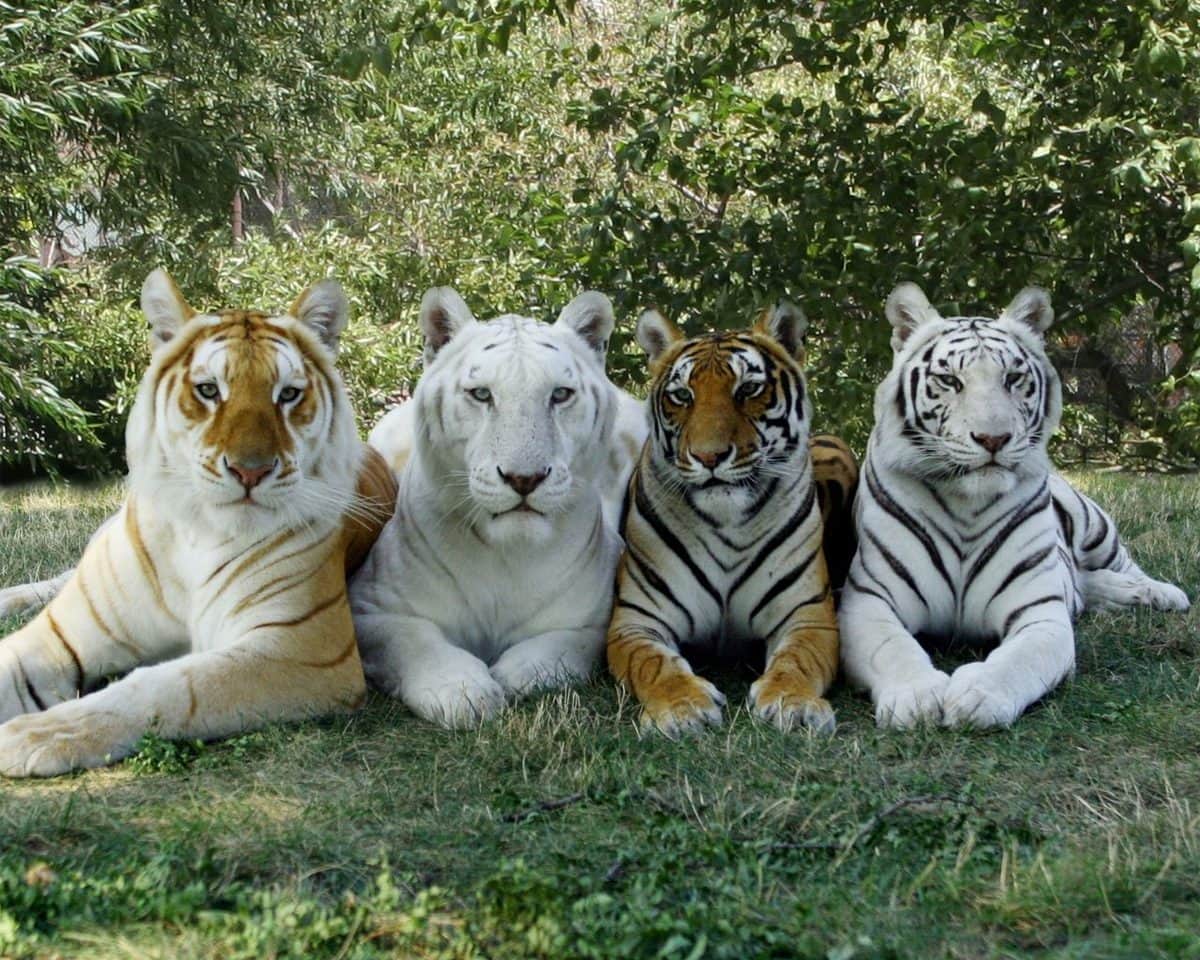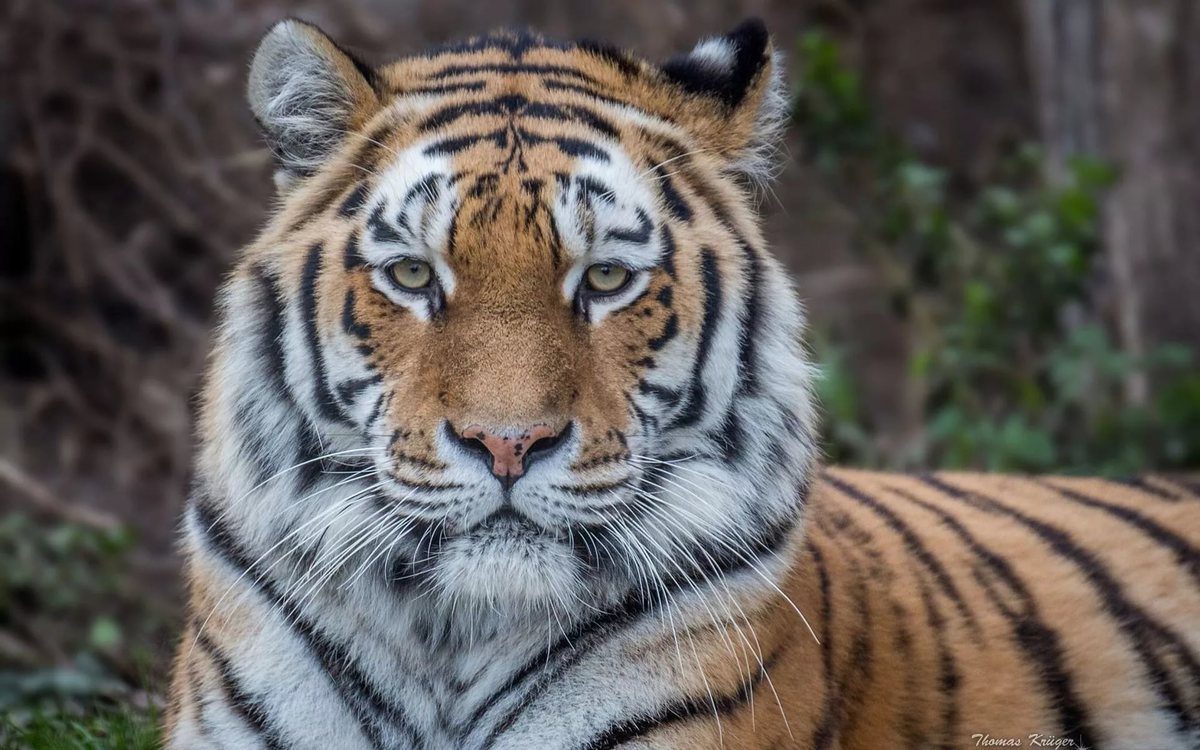
10 interesting facts about Amur tigers – beautiful and majestic animals
The Amur tiger is considered the northernmost subspecies of tigers, its other name is the Far East. He received such a name, because. lives near the Amur and Ussuri rivers. He has an elongated, beautiful, flexible body, the main color is orange, but the belly is a delicate white color. The coat is very thick, there is a layer of fat on the stomach (5 cm), which protects it from the cold and the north wind.
In nature, this subspecies of the tiger lives for about fifteen years, in a zoo they can live more than 20. It is active at night.
Each of the tigers prefers to hunt in its territory, and if there is enough food, it does not leave it. He has a huge one – from 300 to 800 km². He hunts small mammals, deer, roe deer, elk, bears, usually 1 attempt out of 10 is successful. He always attacks 1 time, again – very rarely. He needs at least 10 kg of meat per day.
Here are 10 more interesting facts about the Amur tigers that cannot but interest you.
Contents
- 10 The first tigers appeared over two million years ago.
- 9. Now there are 6 subspecies of tigers, over the past century 3 subspecies have disappeared
- 8. All types of tigers are listed in the Red Book
- 7. Marking territory in different ways
- 6. Saliva has a disinfecting effect
- 5. On average, tigers eat twice as much meat as lions.
- 4. solitary animals
- 3. Wildlife reserves in India wear masks on the back of their heads to reduce the risk of a tiger attacking from behind.
- 2. Mainland tigers are larger than island tigers
- 1. In China, tigers are considered king animals.
10 The first tigers appeared over two million years ago.
 To trace the history of tigers, fossil remains have been analyzed. But there are not so many of them, they are highly fragmented. It was possible to establish that The very first tigers appeared in China. The earliest remains were from 1,66 to 1 million years ago, i.e. then these animals have already settled throughout East Asia.
To trace the history of tigers, fossil remains have been analyzed. But there are not so many of them, they are highly fragmented. It was possible to establish that The very first tigers appeared in China. The earliest remains were from 1,66 to 1 million years ago, i.e. then these animals have already settled throughout East Asia.
9. Now there are 6 subspecies of tigers, over the past century 3 subspecies have disappeared
 In total, there were 9 subspecies of tigers, but 3 of them were destroyed by man. These include the Bali tiger, which once lived in Bali. The last representative of this subspecies was seen in 1937.
In total, there were 9 subspecies of tigers, but 3 of them were destroyed by man. These include the Bali tiger, which once lived in Bali. The last representative of this subspecies was seen in 1937.
The Transcaucasian tiger disappeared in the 1960s, he lived in the south of Russia, in Abkhazia and a number of other countries. Javanese could be found on the island of Java, disappeared in the 1980s, but already in the 1950s there were no more than 25 of them.
8. All types of tigers are listed in the Red Book
 The total number of these predators is not so large – only 4 thousand – 6,5 thousand individuals, most of all Bengal tigers, this subspecies makes up 40% of the total. In Russia, in the twentieth century, it was decided to add tigers to the Red Book, in each country these animals are included in their protection documents.
The total number of these predators is not so large – only 4 thousand – 6,5 thousand individuals, most of all Bengal tigers, this subspecies makes up 40% of the total. In Russia, in the twentieth century, it was decided to add tigers to the Red Book, in each country these animals are included in their protection documents.
Now hunting for tigers is banned all over the world. This applies to all types. In the nineteenth century, there were a lot of Amur tigers, but they began to exterminate it, destroying 100 animals a year.
In the 30s of the twentieth century, the situation became worse than ever: about 50 animals remained in the USSR. The reason was not only the hunt for this beast, but the constant deforestation in the area where they live, as well as a decrease in the number of ungulates that he hunts.
In 1947, it was forbidden to hunt the Amur tiger. However, poachers continued to destroy this rare subspecies. In 1986, a lot of animals were killed as well. 3 years before that, almost all ungulates died due to the plague, and tigers began to go to people in search of food, ate livestock and dogs. In the 90s, interest in the bones and skins of tigers increased, as Chinese Buyers paid a lot of money for them.
Since 1995, the protection of the Amur tigers has been taken under control by the state, the situation began to improve. Now there are about five hundred and eighty individuals, but there is still a lot of work to be done.
7. Marking territory in different ways
 Tigers choose a large territory for their life. To show other individuals that the place is occupied, they mark it in different ways.. They can spray urine on tree trunks. Making a new round, the tiger constantly updates its marks.
Tigers choose a large territory for their life. To show other individuals that the place is occupied, they mark it in different ways.. They can spray urine on tree trunks. Making a new round, the tiger constantly updates its marks.
Another way to show who is the boss here is to scratch the trunk of trees. He tries to leave them as high as possible so that the opponent understands that he is dealing with a huge beast. Tigers loosen snow or earth.
Tags are the main way these animals communicate. They can leave urinary marks on trunks, bushes, rocks. First, the tiger sniffs them, then turns around, raises its tail so that it becomes vertical, and ejects urine in a trickle, approximately at a height of 60-125 cm.
6. Saliva has a disinfecting effect
 The saliva of tigers contains natural substances that act on wounds as an antiseptic.. Thanks to this, they recover and heal faster. Therefore, these animals often lick themselves and do not die if they suddenly received a minor injury.
The saliva of tigers contains natural substances that act on wounds as an antiseptic.. Thanks to this, they recover and heal faster. Therefore, these animals often lick themselves and do not die if they suddenly received a minor injury.
5. On average, tigers eat twice as much meat as lions.
 A lion can eat up to 30 kg of meat in one sitting, but an adult animal does not need so much food: a female needs 5 kg of meat to survive, and a male 7 kg. Everything is more complicated with tigers, they are more voracious. In a year, one tiger can eat 50-70 animals, he eats one deer for several days. At one time, he destroys 30-40 kg of meat, if it is a hungry big male, then 50 kg. But these animals endure a small hunger strike without compromising their health due to the layer of fat.
A lion can eat up to 30 kg of meat in one sitting, but an adult animal does not need so much food: a female needs 5 kg of meat to survive, and a male 7 kg. Everything is more complicated with tigers, they are more voracious. In a year, one tiger can eat 50-70 animals, he eats one deer for several days. At one time, he destroys 30-40 kg of meat, if it is a hungry big male, then 50 kg. But these animals endure a small hunger strike without compromising their health due to the layer of fat.
4. solitary animals
 Adult tigers prefer to lead a solitary lifestyle.. Everyone has his own territory, he will desperately defend it. The personal territory belonging to the male is from sixty to one hundred km², the female has much less – 20 km².
Adult tigers prefer to lead a solitary lifestyle.. Everyone has his own territory, he will desperately defend it. The personal territory belonging to the male is from sixty to one hundred km², the female has much less – 20 km².
The male may allow the female to be located on some part of his site. Tigresses from time to time can show aggression towards each other, but if their territories overlap, they usually do not touch the rival.
The males are different. They will never let another tiger into their territory, they will not even allow you to simply pass through it. But males get along with tigresses, even sometimes sharing their prey with them.
3. Wildlife reserves in India wear masks on the back of their heads to reduce the risk of a tiger attacking from behind.
 The tiger always sits in ambush, waiting for its prey at a watering hole or on the trails. He creeps up to his prey, moving with careful steps, trying to crouch to the ground. When it manages to get as close as possible, it overtakes the prey with huge jumps, trying to grab the prey by the throat.
The tiger always sits in ambush, waiting for its prey at a watering hole or on the trails. He creeps up to his prey, moving with careful steps, trying to crouch to the ground. When it manages to get as close as possible, it overtakes the prey with huge jumps, trying to grab the prey by the throat.
It is believed that if the prey notices the tiger, he does not attack her, he will look for another victim. Knowing about this feature of the tiger, in Indian nature reserves, workers put on a mask imitating a human face on the back of their heads. This helps to scare away the tiger, which prefers to attack from behind, from an ambush.
2. Mainland tigers are larger than island tigers
 The tiger is considered the heaviest and largest wild cat, but its subspecies differ from each other. The largest tigers are mainland. The length of a male Amur or Bengal tiger is up to two and a half meters, sometimes up to almost 3 meters without a tail. They weigh about 275 kg, but there are individuals and heavier – 300-320 kg. For comparison, the Sumatran tiger, from the island of Sumatra, weighs much less: adult males – 100-130 kg, tigresses – 70-90 kg.
The tiger is considered the heaviest and largest wild cat, but its subspecies differ from each other. The largest tigers are mainland. The length of a male Amur or Bengal tiger is up to two and a half meters, sometimes up to almost 3 meters without a tail. They weigh about 275 kg, but there are individuals and heavier – 300-320 kg. For comparison, the Sumatran tiger, from the island of Sumatra, weighs much less: adult males – 100-130 kg, tigresses – 70-90 kg.
1. In China, tigers are considered king animals.
 All over the world, the lion is the king of animals, but for the Chinese, it is the tiger.. For them, this is a sacred animal, a symbol of natural strength, military prowess, and masculinity. It was believed that he could and should be imitated, admired.
All over the world, the lion is the king of animals, but for the Chinese, it is the tiger.. For them, this is a sacred animal, a symbol of natural strength, military prowess, and masculinity. It was believed that he could and should be imitated, admired.
Once upon a time, as the Chinese believe, people peacefully coexisted with tigers, moreover, these animals accompanied heroes and gods. The inhabitants of China believed that tigers could defeat demons, so they wore their fangs and claws in a silver frame to scare away evil spirits and stay healthy. At the entrance to many temples, palaces put paired images of these predators.





